You've just noticed a soft, movable lump under your skin. It doesn't hurt, but it's definitely there—and now you can't stop thinking about it. What is it? Should you be worried? Before you spiral into a Google rabbit hole filled with worst-case scenarios, take a breath. There's a good chance what you're feeling is a lipoma—a common, benign fatty lump that affects millions of people worldwide.
Lipomas are one of the most frequently occurring soft tissue growths, yet many people have never heard of them until they discover one on their own body. Understanding what lipomas look like, where they appear, and how to differentiate them from other skin conditions can help you make informed decisions about your health. That's why we've created this comprehensive visual guide to lipoma pictures, complete with detailed explanations to help you identify these harmless growths and know when to seek professional care.
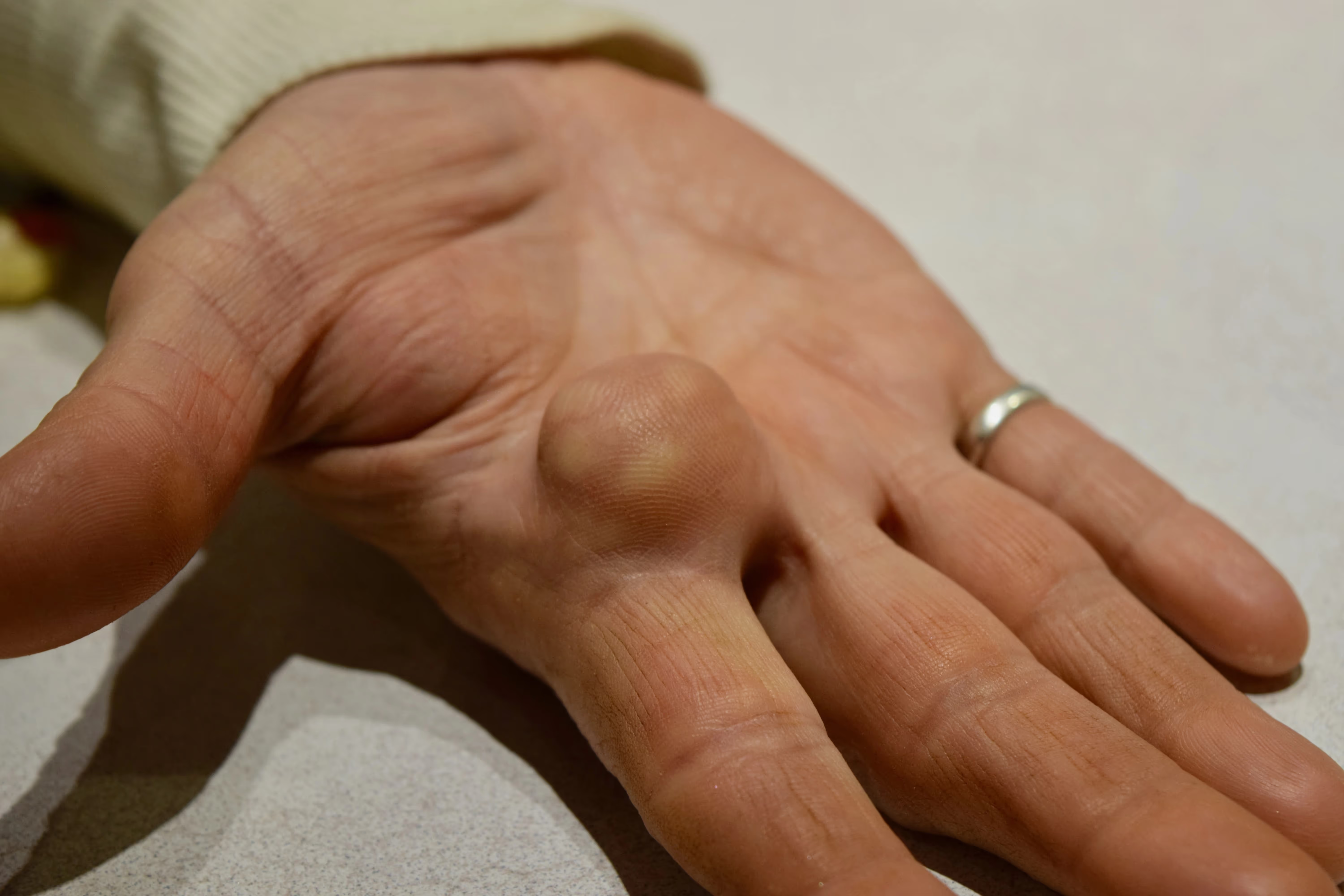
.webp)
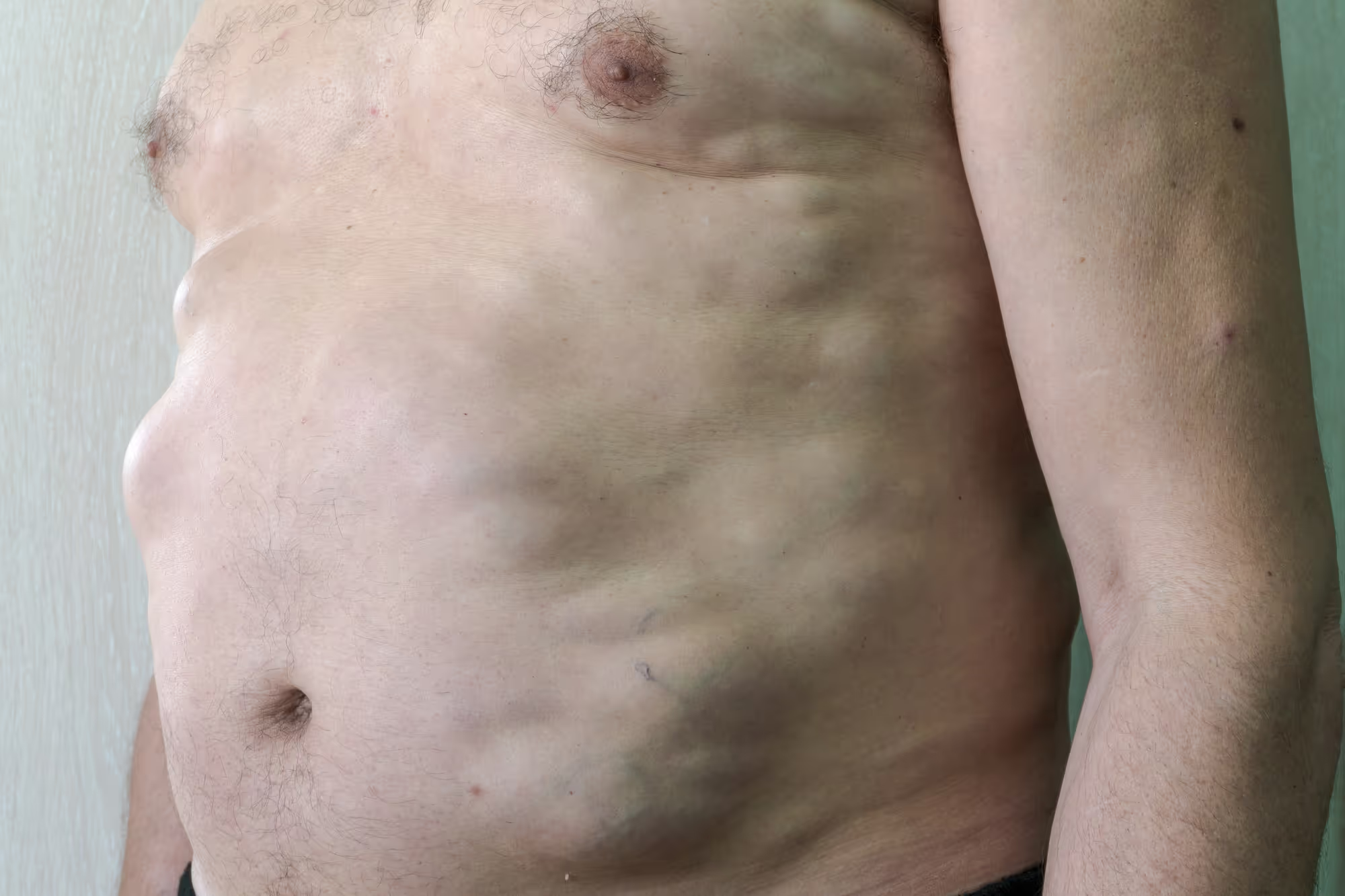
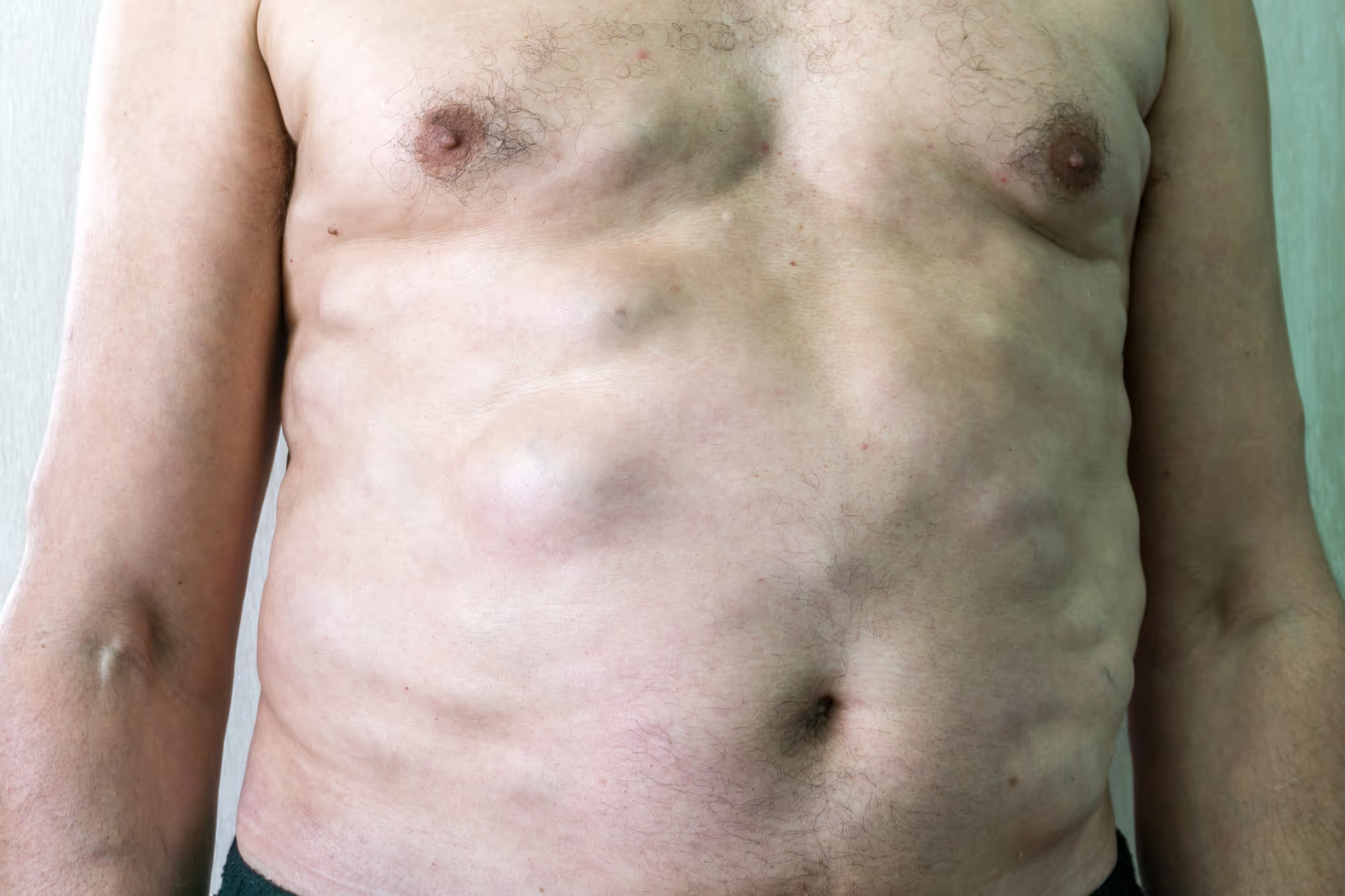
When you're searching for lipoma pictures online, you're likely trying to compare what you see in images to what you're experiencing on your own body. Understanding the visual and physical characteristics of lipomas can help you recognize them more easily.
Lipomas typically present as soft, rubbery lumps that sit just beneath the surface of your skin. Unlike harder cysts or other growths, lipomas have a distinctive doughy or marshmallow-like consistency when you press on them. They're usually round or oval in shape, with smooth edges that make them easy to distinguish from irregular growths.
The skin covering a lipoma generally looks completely normal—there's no discoloration, redness, or visible changes to the surface. This is one key difference between lipomas and other skin conditions like cysts, which may show a visible punctum (small opening) or cause skin changes.
One of the most striking things you'll notice when looking at various lipoma pictures is the incredible range in size. Some lipomas are:
Most lipomas fall into the small-to-medium category, measuring between 1-3 centimeters in diameter. However, they can continue growing slowly over years, which is why some people eventually seek removal even if the lipoma started out tiny.
When examining lipoma pictures, pay attention to these visual markers:
Skin color: The overlying skin maintains its normal color—whether that's fair, medium, olive, or dark. There's no bruising, redness, or purple discoloration unless the lipoma has been irritated or injured.
Surface texture: The skin remains smooth and unchanged. Unlike warts, moles, or skin tags, lipomas don't alter the surface appearance of your skin.
Mobility: While you can't see this in still pictures, lipomas are notably mobile. When you press on them, they slide around under the skin rather than feeling fixed in place.
Lipomas can develop almost anywhere on your body where fat cells exist, but certain areas are more prone to these growths than others. Understanding the most common locations can help you identify whether what you're experiencing matches typical lipoma patterns.
Neck and Shoulders 🎯
The neck and shoulder region is one of the most frequent sites for lipomas. These areas often develop lipomas because of the natural fat deposits that exist there. Neck lipomas can appear:
Shoulder lipomas are particularly common in people who carry tension in this area or have naturally higher fat distribution in their upper body.
Arms and Forearms
Lipomas on the arms typically appear on the upper arm (between the shoulder and elbow) rather than the forearm. They can develop on either the inner or outer surface of the arm and may become more noticeable when you flex your muscles or extend your arm.
Back and Torso
The back is a prime location for lipomas, especially:
Chest and abdomen lipomas are less common but still occur regularly. These may be more bothersome because of clothing friction or visibility concerns.
Thighs and Legs
Thigh lipomas often develop on the outer or inner thigh and can sometimes be confused with muscle or other soft tissue masses. Leg lipomas are less common below the knee but can occur on the calf or even the ankle area.
Buttocks
While less frequently discussed, buttocks lipomas do occur and can be particularly uncomfortable when sitting for extended periods.
Some people develop lipomas in unexpected places:
If you're comparing your growth to lipoma pictures and notice it in an unusual location, that doesn't rule out a lipoma—but it does make professional evaluation even more important.
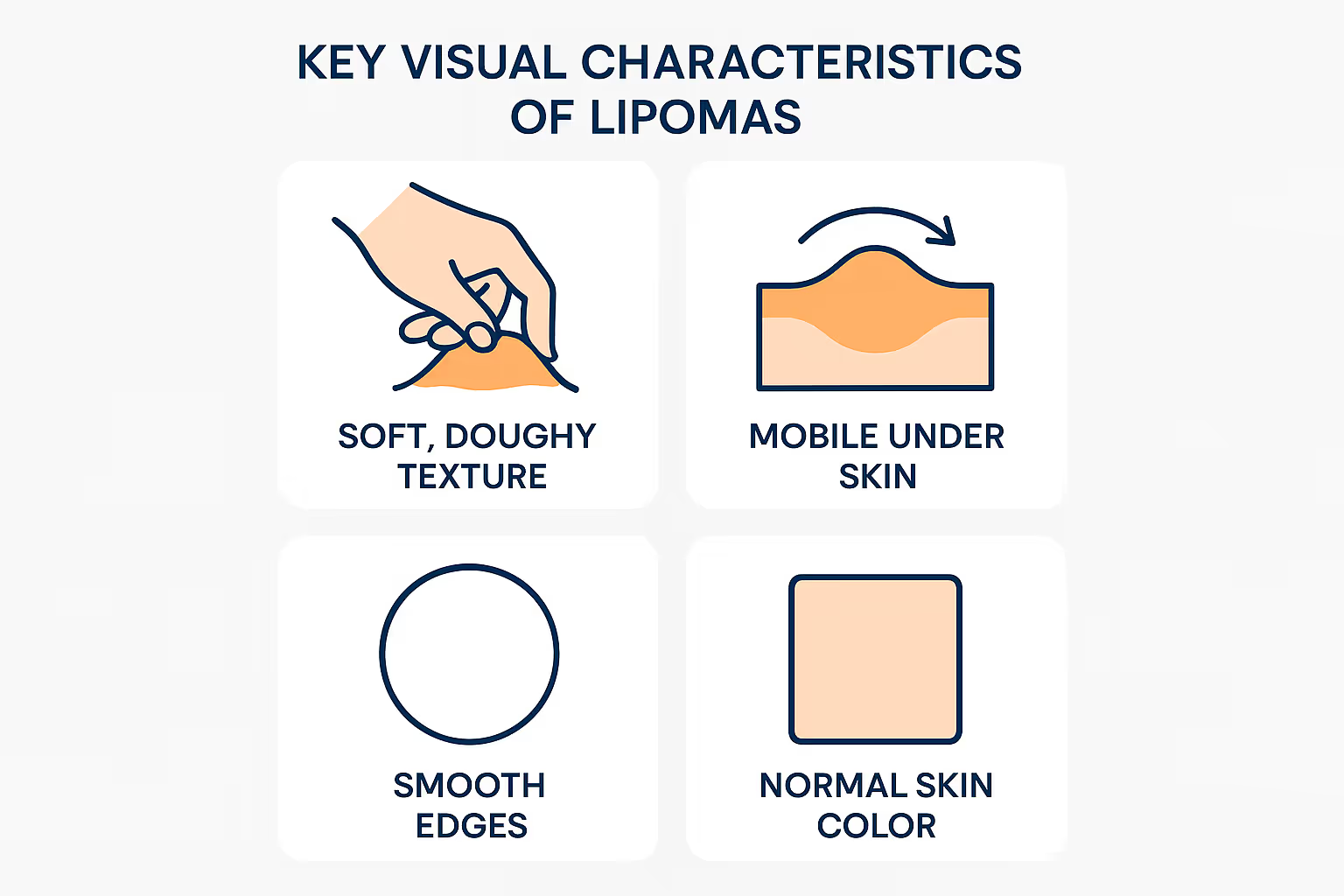
While lipoma pictures provide valuable visual reference, understanding the tactile and behavioral characteristics of lipomas is equally important for identification.
When you examine a suspected lipoma, it should have these features:
✅ Soft and doughy texture: Feels like pressing on a water balloon or soft dough
✅ Mobile under the skin: Moves when you apply gentle pressure
✅ Slow-growing: Develops gradually over months or years
✅ Painless: Generally causes no discomfort unless pressed firmly or located near nerves
✅ Well-defined edges: You can feel where it begins and ends
✅ Located just under the skin: Sits in the subcutaneous layer (between skin and muscle)
Understanding what lipomas don't look or feel like is just as important:
❌ Not hard or firm: Hard lumps may indicate cysts, fibromas, or other conditions
❌ Not fixed in place: Immobile lumps warrant immediate medical attention
❌ Not rapidly growing: Fast growth is atypical and requires evaluation
❌ Not painful: Persistent pain isn't characteristic of simple lipomas
❌ Not red or inflamed: Inflammation suggests infection or other issues
❌ Not irregular or jagged: Smooth, regular borders are typical
"The single most distinguishing feature of a lipoma is its soft, mobile nature. If you can gently move the lump from side to side under your skin, and it feels doughy rather than hard, it's very likely a benign lipoma." — The Minor Surgery Center
One of the biggest challenges when looking at lipoma pictures online is distinguishing them from other common skin growths. Let's break down the key differences.
Epidermoid cysts are often confused with lipomas, but there are important distinctions:
FeatureLipomaCystTextureSoft, doughyFirmer, more solidMobilityVery mobileLess mobileSkin appearanceNormalMay have visible punctum (tiny opening)ContentFat tissueKeratin and cellular debrisGrowth rateVery slowCan grow fasterSmellNoneMay have foul odor if ruptured
Cysts can become infected and inflamed, causing redness, warmth, and pain—symptoms that are rare with lipomas. At The Minor Surgery Center, we regularly help patients distinguish between these conditions and provide appropriate treatment for both.
Swollen lymph nodes can sometimes be mistaken for lipomas, especially in the neck, armpit, or groin areas. Key differences include:
Lymph nodes:
Lipomas:
This is the concern that drives many people to search for lipoma pictures in the first place. While the vast majority of soft tissue lumps are benign, it's important to know when to be concerned.
Liposarcomas (cancerous fatty tumors) are extremely rare but have distinct characteristics:
🚨 Warning signs that warrant immediate medical evaluation:
If you notice any of these features, don't rely on lipoma pictures for diagnosis—seek professional medical evaluation immediately. You can contact our team for a thorough assessment.
Not all lipomas are created equal. There are several subtypes, each with slightly different characteristics that may affect how they appear in pictures and how they feel.
These are the most common type—simple, encapsulated fatty tumors composed of mature white fat cells. They represent about 80-90% of all lipomas and match the classic description we've discussed.
Fibrolipomas contain both fatty tissue and fibrous connective tissue, making them slightly firmer than conventional lipomas. In pictures, they may appear identical to regular lipomas, but when palpated, they feel less doughy and more solid.
These lipomas contain blood vessels in addition to fat cells, which can make them:
More common in men and typically found on the neck, shoulders, and back, spindle cell lipomas contain spindle-shaped cells mixed with fat. They're benign but may require biopsy to rule out other conditions due to their cellular composition.
Some people develop multiple lipomas across their body—a condition called lipomatosis. When looking at pictures of this condition, you'll see:
Conditions like familial multiple lipomatosis and Dercum's disease (adiposis dolorosa) involve multiple painful lipomas and require specialized management.
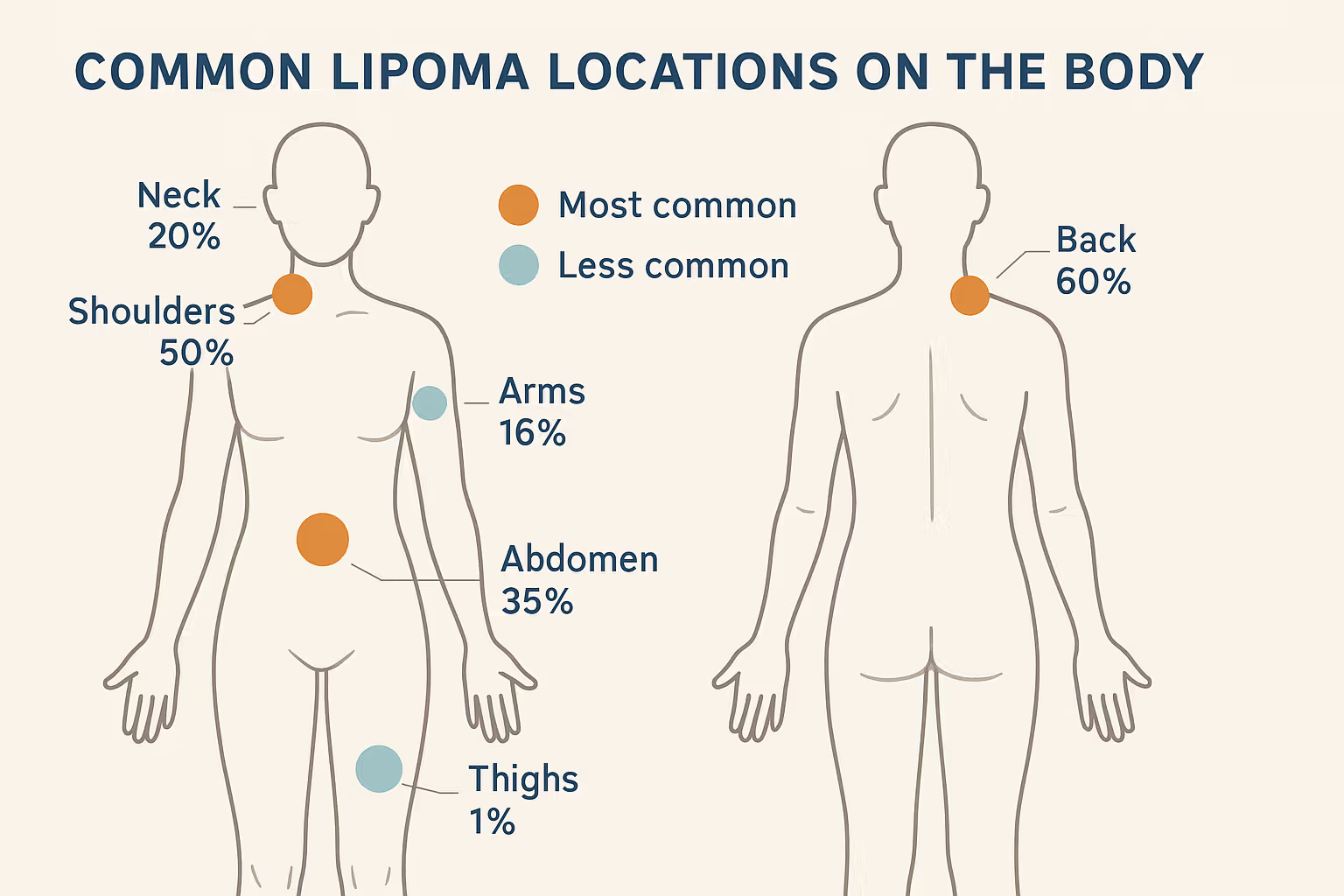
While lipoma pictures can be incredibly helpful for initial identification, they can never replace a professional medical evaluation. Here's when you should absolutely schedule an appointment with a healthcare provider.
Seek medical attention right away if you notice:
🚨 Rapid growth: The lump doubles in size within weeks
🚨 Severe pain: Intense discomfort that interferes with daily activities
🚨 Hardness: The lump feels rock-hard rather than soft
🚨 Immobility: You cannot move the lump under your skin
🚨 Skin changes: Redness, warmth, ulceration, or discoloration
🚨 Systemic symptoms: Fever, night sweats, unexplained weight loss
Schedule a consultation for proper diagnosis if:
✔️ You've discovered a new lump and want confirmation
✔️ The lipoma is growing, even slowly
✔️ You're experiencing discomfort or cosmetic concerns
✔️ The lipoma interferes with movement or daily activities
✔️ You have multiple lumps appearing
✔️ You want to discuss removal options
At The Minor Surgery Center, we understand that discovering a lump can be anxiety-inducing. Our team provides thorough evaluations in a comfortable, reassuring environment—with no long wait times and clear explanations every step of the way.
Understanding what happens during a lipoma evaluation can ease anxiety and help you prepare for your appointment.
Your healthcare provider will:
In many cases, an experienced physician can diagnose a lipoma based on physical examination alone, especially if it has all the classic characteristics.
If there's any uncertainty, your doctor may order:
Ultrasound: The first-line imaging study for soft tissue masses. Ultrasound can:
MRI (Magnetic Resonance Imaging): Reserved for cases where:
CT Scan: Less commonly used for lipomas but may be ordered if the growth is in a complex location or if other conditions are being evaluated simultaneously.
A biopsy involves removing a small tissue sample for microscopic examination. This is typically only necessary when:
Most straightforward lipomas diagnosed by experienced physicians don't require biopsy before removal.
Once you've confirmed that your lump is indeed a lipoma, you face a choice: leave it alone or have it removed. Many people choose removal for cosmetic reasons, discomfort, or peace of mind.
Consider lipoma removal if:
💡 Cosmetic concerns: The lipoma is visible and affects your confidence
💡 Physical discomfort: It rubs against clothing, restricts movement, or causes pain
💡 Growth: The lipoma is getting larger
💡 Uncertainty: You want definitive diagnosis through pathological examination
💡 Preference: You simply prefer not to have it
Surgical removal is the most common and effective treatment for lipomas. The procedure typically involves:
Before the procedure:
During the procedure:
After the procedure:
At The Minor Surgery Center, we specialize in efficient, comfortable lipoma removal. Our expert surgical team performs these procedures regularly, ensuring minimal scarring and excellent cosmetic results.
Liposuction: For some lipomas, especially softer ones, liposuction can remove the fatty tissue through a tiny incision. However:
Steroid Injections: Can shrink some lipomas but rarely eliminate them completely. This is typically reserved for cases where surgery isn't appropriate.
Observation: Many lipomas never require treatment. If yours is small, painless, and not bothersome, simply monitoring it is a perfectly reasonable approach.
When a lipoma is completely excised (including its capsule), recurrence is rare—typically less than 5%. However:
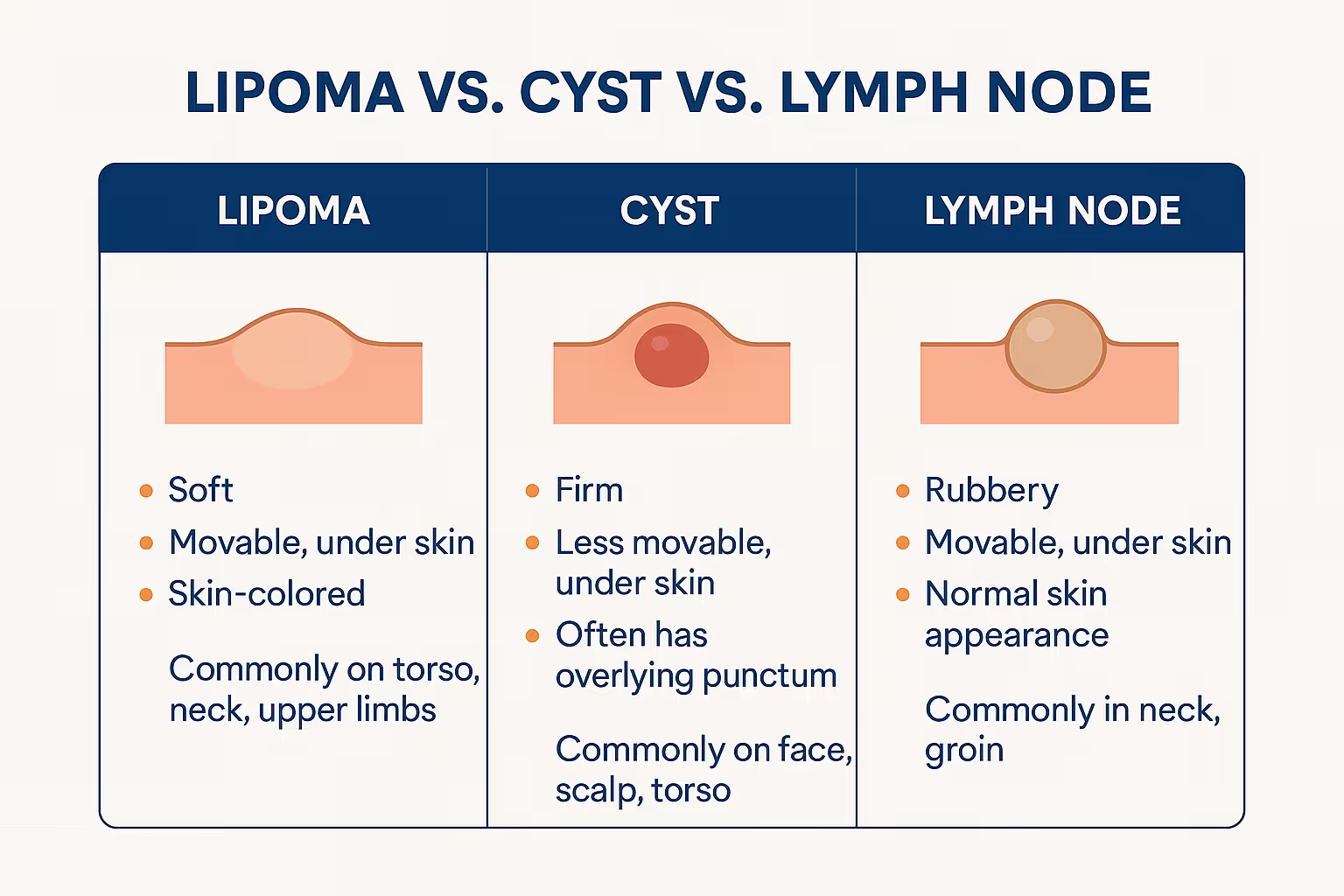
If you've decided not to have your lipoma removed, or you're waiting for a scheduled procedure, here's what you should know about living with these benign growths.
Keep track of your lipoma by:
📸 Taking pictures: Document the size and appearance every few months
📏 Measuring periodically: Use a soft tape measure to track dimensions
📝 Noting changes: Record any changes in texture, mobility, or symptoms
🗓️ Scheduling check-ups: Have it evaluated annually or if changes occur
Unfortunately, there's no proven way to prevent lipomas. They're not caused by:
❌ Diet or nutrition
❌ Lack of exercise
❌ Poor hygiene
❌ Injury or trauma (though trauma may make an existing lipoma more noticeable)
Lipomas appear to have a genetic component, meaning they tend to run in families. If your parents or siblings have lipomas, you're more likely to develop them as well.
While you can't prevent lipomas, maintaining overall health is always beneficial:
✅ Maintain a healthy weight: While lipomas aren't caused by obesity, excess body fat may make them more noticeable
✅ Stay active: Regular exercise supports overall health
✅ Monitor your skin: Regular self-examinations help you notice any changes early
✅ Manage stress: Some research suggests stress may influence lipoma development, though evidence is limited
If you're developing multiple lipomas, consider:
No, lipomas are benign (non-cancerous) growths and are not dangerous. They don't spread to other parts of the body and rarely cause complications. However, any new lump should be evaluated by a healthcare professional to confirm the diagnosis.
Most lipomas are completely painless. However, they can become uncomfortable if they:
Lipomas do not turn into cancer. They are benign fatty tumors and remain benign throughout their existence. However, liposarcomas (cancerous fatty tumors) can occur independently and may initially be mistaken for lipomas. This is why professional evaluation is important.
Lipomas do not disappear without treatment. Once formed, they typically remain stable or grow slowly over time. Surgical removal is the only reliable way to eliminate a lipoma.
The cost of lipoma removal varies based on:
Many insurance plans cover lipoma removal when it's medically necessary (causing pain, restricting movement, or growing). For specific pricing information, contact our team for a consultation.
Recovery is typically quick:
Your specific recovery will depend on the size and location of the lipoma removed.
Medical imagery has historically underrepresented diverse skin tones, making it harder for people with darker skin to identify conditions. When searching for lipoma pictures, it's important to understand how they appear across the full spectrum of skin colors.
On lighter skin tones:
On medium skin tones:
On darker skin tones:
At The Minor Surgery Center, our experienced team understands the unique considerations for patients of all skin tones and employs techniques to minimize scarring and optimize cosmetic outcomes for everyone.
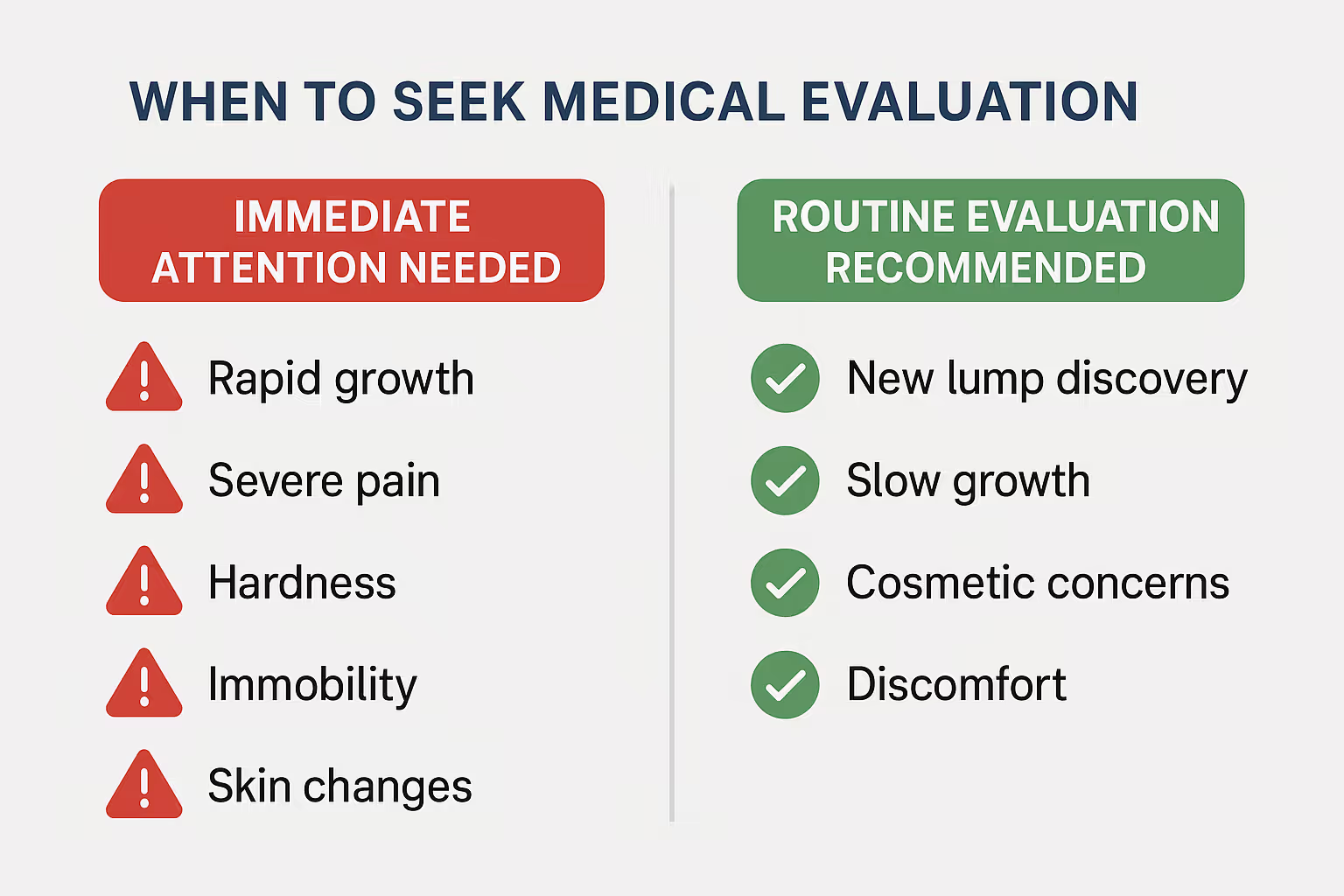
While lipomas are less common in children than adults, they do occur in pediatric populations.
Lipomas in children:
Consult a pediatrician or specialist if your child has:
🔍 A lump that's growing rapidly
🔍 Multiple lumps appearing simultaneously
🔍 Pain or discomfort from the growth
🔍 A family history of multiple lipomas
🔍 Any concerning symptoms
Decisions about treating pediatric lipomas involve:
Many pediatric lipomas can be safely observed until the child is older, unless they're causing problems or concern.
Understanding what different imaging studies show can help you make sense of your medical workup.
Ultrasound is the most common imaging modality for lipomas because it's:
What ultrasound shows:
MRI provides the most detailed soft tissue imaging and shows:
Imaging findings that may prompt further investigation include:
These findings don't necessarily mean cancer, but they warrant additional evaluation, possibly including biopsy.
One common concern about lipoma removal is scarring. Understanding what to expect can help you make informed decisions.
Several factors influence how your scar will look:
Lipoma-related factors:
Individual factors:
Surgical factors:
To optimize your scar appearance:
✨ Choose an experienced surgeon: Skilled technique makes a significant difference
✨ Follow post-op instructions: Proper wound care is essential
✨ Avoid sun exposure: UV light can darken scars
✨ Consider scar treatments: Silicone sheets, massage, or topical treatments
✨ Be patient: Scars continue improving for 12-18 months
Our team at The Minor Surgery Center uses meticulous surgical techniques designed to minimize scarring while ensuring complete lipoma removal.
Week 1-2: Incision line is red and raised
Month 1-3: Scar begins to flatten and fade
Month 3-6: Significant improvement in appearance
Month 6-18: Continued maturation and fading
After 18 months: Final scar appearance achieved
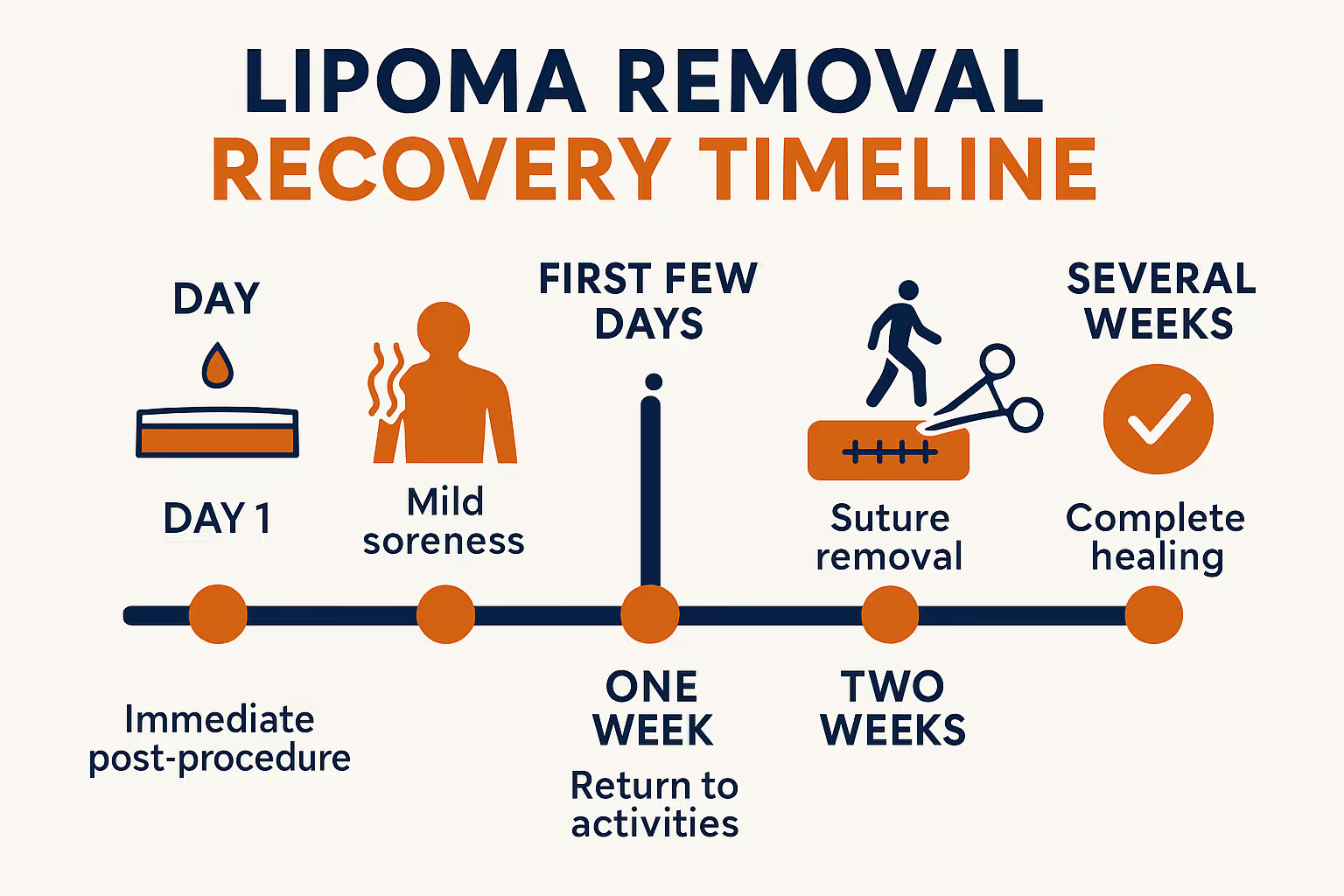
Understanding insurance coverage for lipoma removal can help you plan financially.
Most insurance plans cover lipoma removal when it's considered medically necessary:
✅ Painful lipomas: Causing significant discomfort
✅ Functional impairment: Restricting movement or interfering with daily activities
✅ Growing lipomas: Demonstrating continued enlargement
✅ Uncertain diagnosis: When biopsy is needed to rule out other conditions
✅ Complicated location: Near nerves, blood vessels, or organs
Coverage may be denied for:
❌ Purely cosmetic concerns: Small, asymptomatic lipomas removed only for appearance
❌ Lack of documentation: Insufficient medical records showing medical necessity
❌ Elective timing: Choosing removal without documented symptoms
To improve the likelihood of coverage:
📋 Document symptoms: Keep records of pain, growth, or functional limitations
📋 Get pre-authorization: Have your doctor submit a pre-authorization request
📋 Provide imaging: Include ultrasound or other imaging results
📋 Detailed physician notes: Ensure your doctor documents medical necessity
For questions about coverage and costs, our team can help you navigate the insurance process. Visit our FAQs page for more information.
While lipomas are well-understood, research continues to explore their causes and develop new treatment approaches.
Genetic studies: Researchers are investigating:
Molecular mechanisms: Scientists are studying:
Treatment innovations: Emerging approaches include:
While surgical excision remains the gold standard, future treatments may include:
🔬 Targeted medications: Drugs that specifically shrink lipomas without surgery
🔬 Advanced imaging: Better techniques to distinguish benign from malignant fatty tumors
🔬 Minimally invasive procedures: Refined techniques with even smaller incisions
🔬 Prevention strategies: If genetic factors are better understood, prevention may become possible
Now that you've learned about lipoma pictures, identification, and treatment options, you're equipped to make informed decisions about your health.
At The Minor Surgery Center, we understand that discovering a lump—even a benign one—can be stressful. That's why we've created an environment focused on:
🏥 Expert care: Our surgical team has extensive experience with lipoma diagnosis and removal
🏥 Clear communication: We explain everything in plain language, without medical jargon
🏥 Efficient service: No long wait times—we respect your schedule
🏥 Compassionate approach: We treat every patient with dignity and understanding
🏥 Transparent pricing: No hidden fees or surprises
Whether you need a simple consultation or complete lipoma removal, we're here to help you feel confident in your skin again.
Lipoma pictures serve as a valuable starting point for understanding these common, benign fatty growths. By learning to recognize the characteristic soft, mobile, painless lumps that define lipomas, you're better equipped to identify them and distinguish them from other conditions.
However, pictures alone can never replace professional medical evaluation. While the images and descriptions in this guide provide helpful reference, only a qualified healthcare provider can definitively diagnose a lipoma and recommend appropriate treatment.
If you've discovered a lump that concerns you, don't let anxiety or uncertainty hold you back from seeking care. Modern lipoma removal is a straightforward, safe procedure with excellent outcomes and minimal downtime. Whether your concern is cosmetic, functional, or simply peace of mind, professional evaluation is your first step toward resolution.
Remember: you deserve to feel confident and comfortable in your own skin. Expert care is available, accessible, and designed to make the process as simple and stress-free as possible.
Ready to get answers about your lipoma? Contact The Minor Surgery Center today to schedule a consultation. Our experienced team is here to provide the expert care and clear guidance you deserve—without the wait, without the worry, and with your comfort as our priority.
For more information about the conditions we treat and the procedures we offer, visit our conditions page or explore our blog for additional health resources.